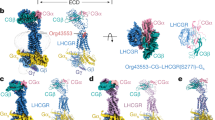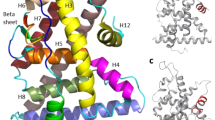Abstract
The physiological effects of progestins are mediated by the progesterone receptor, a member of the steroid/nuclear receptor superfamily1. As progesterone is required for maintenance of pregnancy, its receptor has been a target for pharmaceuticals2. Here we report the 1.8 Å crystal structure of a progesterone-bound ligand-binding domain of the human progesterone receptor. The nature of this structure explains the receptor's selective affinity for progestins and establishes a common mode of recognition of 3-oxy steroids by the cognate receptors. Although the overall fold of the progesterone receptor is similar to that found in related receptors3,4,5,6, the progesterone receptor has a quite different mode of dimerization3,6. A hormone-induced stabilization of the carboxy-terminal secondary structure of the ligand-binding domain of the progesterone receptor accounts for the stereochemistry of this distinctive dimer, explains the receptor's characteristic pattern of ligand-dependent protease resistance and its loss of repression7,8, and indicates how the anti-progestin RU486 might work in birth control. The structure also indicates that the analogous 3-keto-steroid receptors may have a similar mechanism of action.
This is a preview of subscription content, access via your institution
Access options
Subscribe to this journal
Receive 51 print issues and online access
$199.00 per year
only $3.90 per issue
Buy this article
- Purchase on Springer Link
- Instant access to full article PDF
Prices may be subject to local taxes which are calculated during checkout



Similar content being viewed by others
References
Evans, R. M. The steroid and thyroid hormone receptor superfamily. Science 240, 889–895 (1988).
Baulieu, E.-E. Contragestion and other clinical applications of RU486, an antiprogesterone at the receptor. Science 245, 1351–1357 (1989).
Bourguet, W., Ruff, M., Chambon, P., Gronemeyer, H. & Moras, D. Crystal structure of the ligand-binding domain of the human nuclear receptor RXR-alpha. Nature 375, 377–382 (1995).
Renaud, J. P. et al. Crystal structure of the RAR-gamma ligand-binding domain bound to all-trans retinoic acid. Nature 378, 681–689 (1995).
Wagner, R. L. et al. Astructural role for hormone in the thyroid hormone receptor. Nature 378, 690–697 (1995).
Brzozowski, A. et al. Molecular basis of agonism and antagonism in the oestrogen receptor. Nature 389, 753–757 (1997).
Xu, J., Nawaz, Z., Tsai, S. Y., Tsai, M. J. & O'Malley, B. W. The extreme C terminus of progesterone receptor contains a transcriptional repressor domain that functions through a putative corepressor. Proc. Natl Acad. Sci. USA 93, 12195–12199 (1996).
Klotzbucher, M., Schwerk, C., Holewa, B. & Klein-Hitpass, L. Activation of transcription by progesterone receptor involves derepression of activation functions by a cofactor. Mol. Endocrinol. 11, 768–778 (1997).
Jenster, G. et al. Domains of the human androgen receptor involved in steroid binding, transcriptional activation, and subcellular localization. Mol. Endocrinol. 5, 1396–1404 (1991).
Lanz, R. & Rusconi, S. Aconserved carboxy-terminal subdomain is important for ligand interpretation and transactivation by nuclear receptors. Endocrinology 135, 2183–2195 (1996).
Zhang, S., Liang, X. & Danielsen, M. Role of the C terminus of the glucocorticoid receptor in hormone binding and agonist/antagonist discrimination. Mol. Endocrinol. 10, 24–34 (1996).
Allan, G. F. et al. Hormone and antihormone induce distinct conformational changes which are central to steroid receptor activation. J. Biol. Chem. 267, 19513–19520 (1992).
Skafar, D. F. Differential DNA binding by calf uterine estrogen and progesterone receptors results from differences in oligomeric states. Biochemistry 30, 6148–6154 (1991).
Rodriguez, R., Weigel, N. L., O'Malley, B. W. & Schrader, W. T. Dimerization of the chicken progesterone receptor in vitro can occur in the absence of hormone and DNA. Mol. Endocrinol. 4, 1782–1790 (1990).
Tetal, M. J. et al. Hinge and amino-terminal sequences contribute to solution dimerization of human progesterone receptor. Mol. Endocrinol. 11, 1114–1128 (1997).
DeMarzo, A. M., Onate, S. A., Nordeen, S. K. & Edwards, D. P. Effects of the steroid antagonist RU486 on dimerization of the human progesterone receptor. Biochemistry 31, 10491–10501 (1992).
Skafar, D. F. Dimerization of the RU486-bound calf uterine progesterone receptor. J. Steroid Biochem. Mol. Biol. 44, 39–43 (1993).
Edwards, D. P. et al. Progesterone receptor and the mechanism of action of progesterone antagonists. J. Steroid Biochem. Mol. Biol. 53, 449–458 (1995).
Benhamou, B. et al. Asingle amino acid that determines the sensitivity of progesterone receptors to RU486. Science 255, 206–209 (1992).
Zenke, M., Munoz, A., Sap, J., Vennstrom, B. & Beug, H. v-erbA oncogene activation entails the loss of hormone-dependent regulator activity of c-erba. Cell 61, 1035–1049 (1990).
1. Durand, B. et al. Activation function 2 (AF-2) of retinoic acid receptor and 9-cis retinoic acid receptor: presence of a conserved autonomous constitutive activating domain and influence of the nature of the response element on AF-2 activity. EMBO J. 13, 5370–5382 (1994).
LeDouarin, B. et al. Ligand-dependent interaction of nuclear receptors with potential transcriptional intermediary factors (mediators). Phil. Trans. R. Soc. Lond. B 351, 569–578 (1996).
Thenot, S., Henriquet, C., Rochefort, H. & Cavailles, V. Differential interaction of nuclear receptors with the putative human transcriptional coactivator hTIF1. J. Biol. Chem. 272, 12062–12068 (1997).
Collingwood, T. et al. Anatural transactivation mutation in the thyroid hormone beta receptor: impaired interaction with putative transcriptional mediators. Proc. Natl Acad. Sci. USA 94, 248–253 (1997).
Jeyakumar, M., Tanen, M. & Bagchi, M. Analysis of the functional role of steroid receptor coactivator-1 in ligand-induced transactivation by thyroid hormone receptor. Mol. Endocrinol. 11, 755–767 (1997).
Vegeto, E. et al. The mechanism of RU486 antagonism is dependent on the conformation of the carobxy-terminal tail of the human progesterone receptor. Cell 69, 703–713 (1992).
Otwinowski, Z. & Minor, W. Processing X-ray diffraction data collected in oscillation mode. Meth. Enzymol. 276, 307–326 (1997).
Wishart, D., Boyko, R. & Sykes, B. Constrained multiple sequence alignment using XALIGN. Cabios 10, 687–688 (1994).
Acknowledgements
We thank M.-J. Tsai and B. O'Malley for the cDNA fragment containing the coding segment for the protein used here; C. Ogata (X4A-NSLS), L. Berman (X25-NSLS) and S. Ealick (CHESS) for access to and help with synchrotron radiation; R. Fletterick and D. Moras for useful structural information; D. Tanenbaum and Y.Wang for access to and discussions about their crystal structure of the oestradiol-ER-LBD complex; and members of P.B.S.'s laboratory for help with data collection. This work was supported in part by an NIH grant.
Author information
Authors and Affiliations
Corresponding author
Supplementary Information
Rights and permissions
About this article
Cite this article
Williams, S., Sigler, P. Atomic structure of progesterone complexed with its receptor. Nature 393, 392–396 (1998). https://doi.org/10.1038/30775
Received:
Accepted:
Issue Date:
DOI: https://doi.org/10.1038/30775
This article is cited by
-
A progesterone derivative linked to a stable phospholipid activates breast cancer cell response without leaving the cell membrane
Cellular and Molecular Life Sciences (2024)
-
Sfcnn: a novel scoring function based on 3D convolutional neural network for accurate and stable protein–ligand affinity prediction
BMC Bioinformatics (2022)
-
Stochastic model of ERK-mediated progesterone receptor translocation, clustering and transcriptional activity
Scientific Reports (2022)
-
Cytostatic Activity and Ligand-Receptor Interaction Energy of the Novel Russian-Produced Gestagen Gestobutanoil and its Metabolites
Pharmaceutical Chemistry Journal (2021)
-
A hydrophobic ratchet entrenches molecular complexes
Nature (2020)
Comments
By submitting a comment you agree to abide by our Terms and Community Guidelines. If you find something abusive or that does not comply with our terms or guidelines please flag it as inappropriate.



